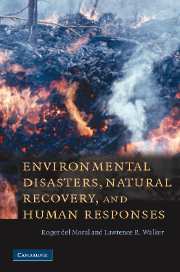Book contents
- Frontmatter
- Contents
- Preface and acknowledgements
- 1 Introduction: a crescendo of destruction
- 2 Natural disturbances: synergistic interactions with humans
- 3 Infertile and unstable habitats
- 4 Infertile and stable habitats
- 5 Fertile and unstable habitats
- 6 Fertile and stable habitats
- 7 The lessons learned
- Glossary
- Illustration credits
- Index
- Plate section
- References
1 - Introduction: a crescendo of destruction
Published online by Cambridge University Press: 11 September 2009
- Frontmatter
- Contents
- Preface and acknowledgements
- 1 Introduction: a crescendo of destruction
- 2 Natural disturbances: synergistic interactions with humans
- 3 Infertile and unstable habitats
- 4 Infertile and stable habitats
- 5 Fertile and unstable habitats
- 6 Fertile and stable habitats
- 7 The lessons learned
- Glossary
- Illustration credits
- Index
- Plate section
- References
Summary
DISTURBANCE AND HUMAN INTERACTIONS
The pristine world of the past was filled with cataclysms. Volcanoes, earthquakes, floods and fires shaped today's landscapes and every living organism evolved in response to natural disturbance. What we call Nature survived in a finely tuned balancing act between the forces of destruction and recovery. Recovery of Nature after destruction was inevitable, but it occurred at variable rates and with a constantly evolving mix of plants and animals. Occasionally natural disturbances were so violent that many species became extinct. Today, the rules have changed; humans have profoundly altered the balance of destruction and recovery, by intensifying natural disturbances and creating many novel ones, without an equal emphasis on recovery. What are the consequences of this meddling by humans with the future of this planet?
Humans have always been at the mercy of large natural disturbances, though we try to forget this fact. The Minoans left little but legends (e.g. Atlantis) after the massive eruption of Santorini (Thera) in about 1623 BC. Agriculture in Japan suffered terrible blows from sixth century volcanic eruptions, as did the economies of both Iceland and Europe by the eruptions of Laki in 1783. Yet we continue to build on active volcanoes, steep slopes prone to erosion and floodplains subject to flooding. Recently, we have felt a growing, yet false, sense of protection from the natural forces of destruction because many of us now live in safe, artificially created environments.
- Type
- Chapter
- Information
- Publisher: Cambridge University PressPrint publication year: 2007



